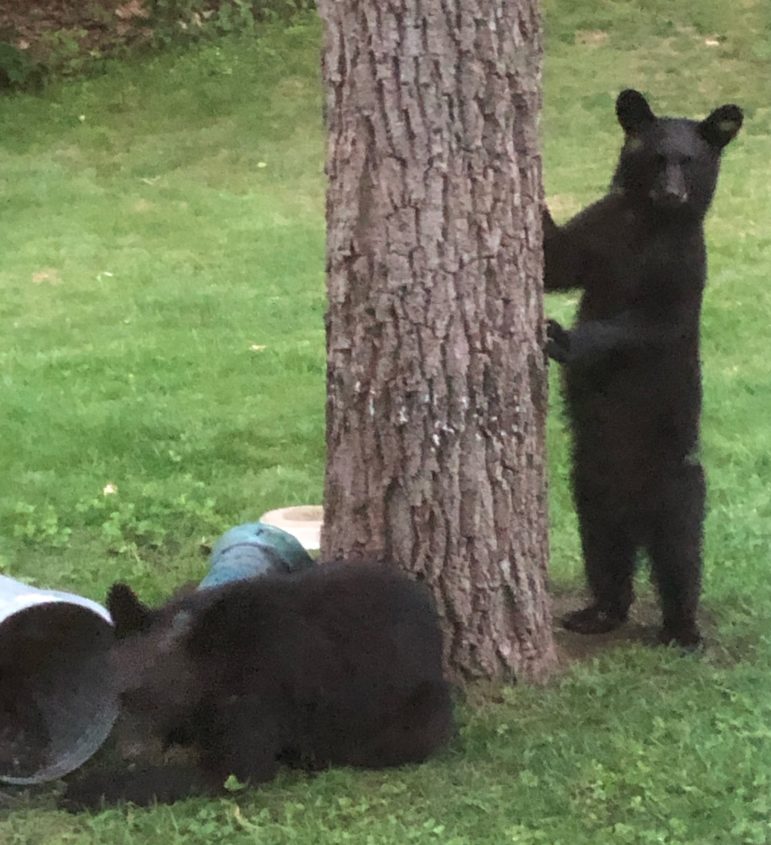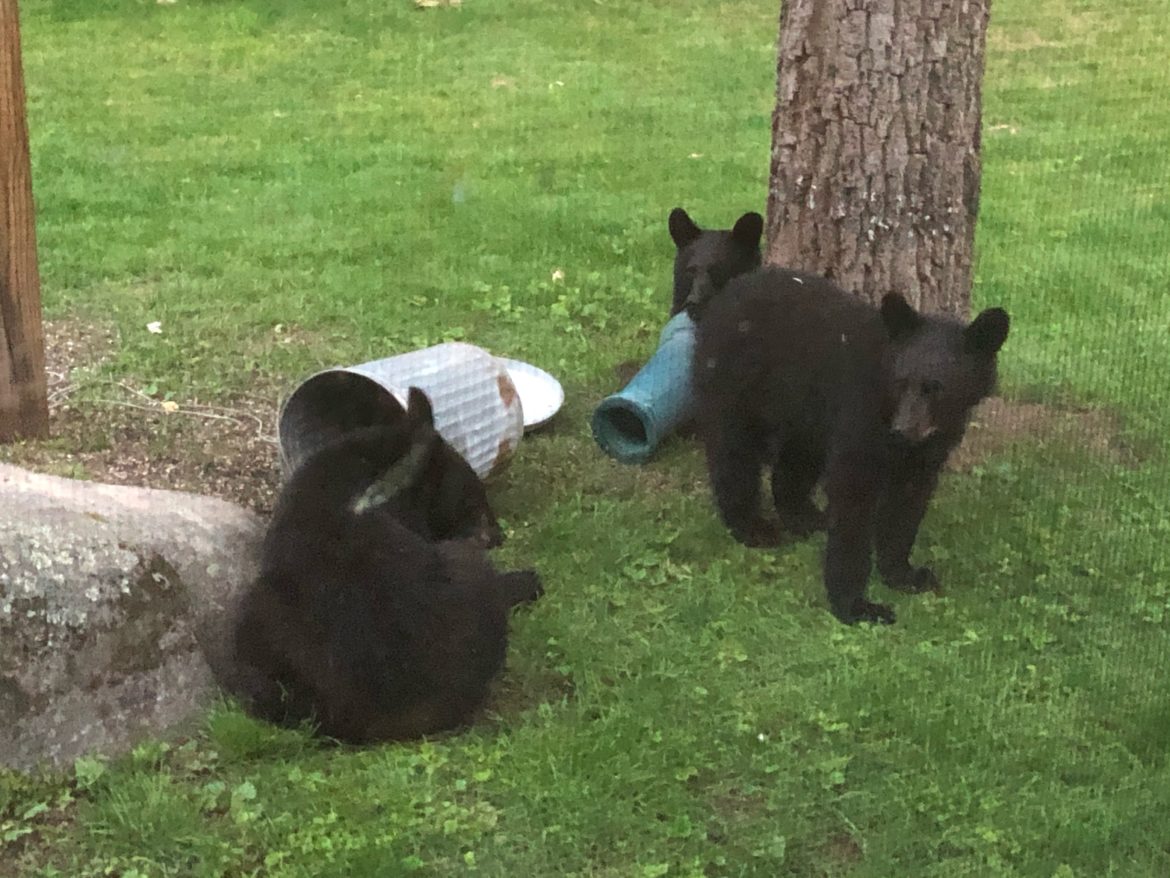
By PAULA TRACY, InDepthNH.org
I had a family of four bears in my yard at dusk this past week.
It was a startling reminder that the season for feeding birds and bears is now over. But it was a magnificent sight.
The galvanized can of black oil sunflower seed is now empty and the birds will be just fine though they continue to come and look around for scraps. They have the bears to thank for that.
New Hampshire has 1.4 million residents and fewer than 5,000 black bears, which makes them a pretty precious commodity.
Conflict with bears has been on the rise in the past decade, particularly due to backyard chicken farmers.
Ben Kilham, at the nonprofit Kilham Bear Center in Lyme, said Friday morning that the season is shaping up to be good with lots of signs that the bear’s favorite natural foods will soon ripen and fill their bellies. That often keeps the trouble down.
He told me my black oil sunflower seed is highly prized by the bruins and likely it was not my leftover acorns scattered across the lawn that brought them in.
Kilham has relocated 40 bear cubs from last season into the woods and is hosting a handful of this year’s orphans, many of whom have lost their mothers to chicken farmers with guns.
“A simple electric fence keeps bears out,” he said.
Over the past 30 years, he has taken in 350 bears.
Three years ago, his home-based operation became a non-profit, the Kilham Bear Center https://kilhambearcenter.org/.
He now uses social media to ask folks to bring acorns, when needed, to a bin at the bottom of this driveway which has served as a life-saver for the cubs.
Both Vermont and New Hampshire have an equal number of cubs at the facility now, which this weekend is officially finishing up a building addition, now with two bear enclosures at the center. One is eight acres in size and the other is 11 acres.
Now he won’t have to kick out all last year’s cubs to make way for the new wave. Of the 350 bears he has released only about 25 percent have been taken by hunting and hardly any have been involved in conflicts like chicken coop raids.
They are tagged so they can be followed through life and many of them do very well in the wild.
Though most of the early years saw a cub or two winter-over, it started to increase in 2008 when there was an economic downturn and people began raising chickens, Kilham said. Add that to the boom and bust of natural foods and there can be huge fluctuations in the numbers at the bear center.
In 2018, he had 84 cubs on his property, a record high.
A mast food crop failure can find bears searching far for something to eat and getting into trouble with humans.
My Bad
I am entirely to blame for attracting bears to my yard and should have taken my feeders down by April 1 as Fish and Game instruct. I can safely place the feeder back out on Dec. 1.
But usually, I finish up feeding when I am out of seed. I bought in bulk this winter and there was still about four pounds left in the can when the sow tipped it over and her three cubs came out of the woods to join in the picnic.
Before knowing they were there I felt a strange presence outside and some unfamiliar noises.
While watching The Crown on Netflix, out of the corner of my eye I spotted a big black moving blob near the walnut tree where both the feeders and the can are kept.
A magnificent mother bear had with her three cubs, one of whom looked like last year’s.
She turned the can at one point to fan out the seed for her two other ones and then sat at a distance in the corner of the yard near the woods to watch them feed on the feeders and the can.
I went to another room to get my cell phone to take a picture and found that just outside that window, climbing the frame of the clothesline to a hanging feeder, was one of the three cubs. He worked to wrestle the seed free from the container. The cub put all its weight on it, hanging from it and it dropped to the ground only to realize that the thistle seed was no good.
At this point, the noise of the yard got the attention of my sleeping dog who went ballistic.
The cubs climbed the tree but her barking indoors was not enough to scare these hungry bears from the yard.
They came down and ate every single black oil sunflower seed in the can.
All this while, the dog is shrieking and barking.
They headed back into the dense forest behind my house with full stomachs but left behind some pretty bummed-out birds the next day.
The damage assessed in the morning was minimal. A broken ceramic birdbath which already had a crack from ice, a few dents in the galvanized can, a feeder in need of re-rigging.
Andy Timmins is the state’s bear project leader. He said it has been thankfully slow this season with few conflicts with bears and people to resolve. He said the hard and soft mast crop season looks good, but we need rain to help produce food.

The season has just begun, however, and it will be followed by fall.
Early spring and no late frost helped but water at least up in Lancaster where he is located is at August levels.
He agreed that chicken coops are a source of conflict and urged folks to call the USDA at 223-6832 for help with electric fencing and noted the department also offers short-term loans of equipment to backyard farmers.
If you are camping, don’t assume there are no bears around. String up your food in a tree and/or close your car windows and keep it inside of car camping.
Here are some more tips for avoiding bear conflict from NH Fish and Game. https://www.wildlife.state.nh.us/wildlife/bears/index.html
Paula Tracy’s first big hike was in 1975 with classmates from Concord up Mount Lafayette with teacher and outdoor enthusiast Ned Bergman. She was 13 and was immediately captured by the wonders of New Hampshire’s great outdoors. It would lead to a lifetime love of exploring the woods, water, and wildlife in the Granite State. As a staff reporter, for 25 years at the NH Union Leader and then for WMUR.com, she has written about the subject extensively and continues here with the hope of connecting New Hampshire’s residents with their own backyard.





